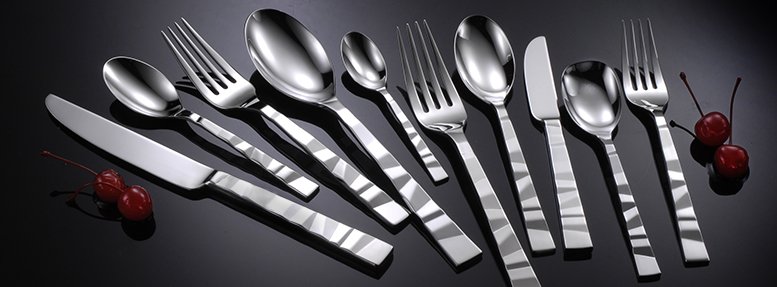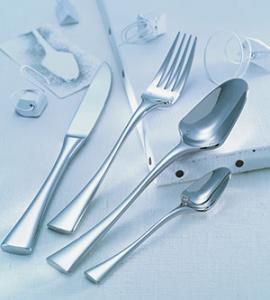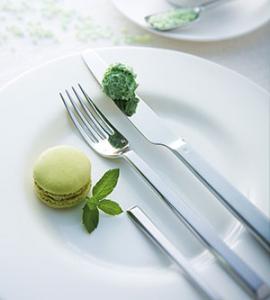Flatware 101 With The King Of Tabletop

It’s important to everyone here at PJP that we stay up to date on the latest trends in the many industries we participate in. That’s why we hire experts in these fields to come work for us, so that we can pass their knowledge and expertise on to you, our customers. For our blog this week, we consulted with one of those experts, our very own King of Tabletop – Bill Daily. Bill is your go to resource for all things Tabletop, and we asked him to share some of that information with our blog readers today. When we asked Bill to share what he would teach in a class called “Flatware 101” this is what he told us:
 “I would like to start by submitting that the foodservice flatware is the most personal item in the dining experience. Not only does the diner pick up the utensils to enjoy their meal, but they also put several of the items into their mouth. The flatware used should speak volumes about the care an operator puts into his food and the respect he feels toward his customer’s experience. For this reason, extreme care should be taken when making a flatware choice.
“I would like to start by submitting that the foodservice flatware is the most personal item in the dining experience. Not only does the diner pick up the utensils to enjoy their meal, but they also put several of the items into their mouth. The flatware used should speak volumes about the care an operator puts into his food and the respect he feels toward his customer’s experience. For this reason, extreme care should be taken when making a flatware choice.
As much as I’d like to sustain the mystery surrounding foodservice flatware, the whole matter can be summed up in just a few paragraphs. Aside from metal composition, there are just a few variables that position a particular flatware in the price spectrum where it fits and they are; weight, finish, sales volume and aesthetics.
Far and away, the most important aspect in choosing a flatware pattern is metal composition. In order for a metal item to be classified as stainless steel in the U.S., it must contain a minimum of 13% chromium (chrome). For many years, entry level flatware was imported into the U.S. in this formulation, but it simply did not hold up. So, the accepted minimum formulation became 18% chromium (18 chrome or 18/0).
To this day, much of the higher volume flatware patterns are 18/0 and many are made in many factories under the same or similar brand names (e.g. Windsor, Dominion, Old English, Beefeater). The fact of the matter is that most operators consider their flatware to be disposable. Even more undeniable is the fact that this product will turn gray, it will rust, it will pit, it will corrode and it is much more likely to be thrown away by careless staff. It is especially affected by low temperature (chemical) dishwashers.
 Many users, especially hotels and clubs, decided long ago that this type of performance would not do, so manufacturers began adding nickel to the metal alloy to help the ware keep its luster and sheen and to make it impervious to rusting, pitting and corrosion. You will often see them represented as 18/8 or 18/10. This means that, in addition to the 18% chromium, the alloy also includes either 8% or 10% nickel. It will retain its out-of-the-box luster for years to come. You should know, however, that nickel is a soft metal and flatware patterns with nickel are more susceptible to abrasions from handling and warewashing.
Many users, especially hotels and clubs, decided long ago that this type of performance would not do, so manufacturers began adding nickel to the metal alloy to help the ware keep its luster and sheen and to make it impervious to rusting, pitting and corrosion. You will often see them represented as 18/8 or 18/10. This means that, in addition to the 18% chromium, the alloy also includes either 8% or 10% nickel. It will retain its out-of-the-box luster for years to come. You should know, however, that nickel is a soft metal and flatware patterns with nickel are more susceptible to abrasions from handling and warewashing.
Most 18/10 patterns are heavier than 18/0, but this is mostly due to the fact that they are targeted toward a higher end customer. Oneidais currently offering several extremely heavyweight 18/0 patterns to bridge the gap between weight and price.
Stainless steel is a commodity, so two other key aspects are weight and sales volume. Like anything else, if it weighs more, it probably costs more. Conversely, if a factory can produce 10,000 dozen of an item at a time rather than 1000, it only stands to reason that the price would be more affordable.
All that being said, it is absolutely crucial that the flatware complement or enhance the dinnerware selected. Lucky for you PJP customers, you have literally hundreds of choices that PJP can offer you to fit your customer’s aesthetic and budget.”
If you’d like to learn more about Flatware or anything else from Bill Daily, just contact your PJP salesperson and they’ll be happy to set up a meeting.
NEED HELP WITH THIS?
Get immediate help with this topic from a certified PJP Product Specialist.
Typical response within 24 hours.

